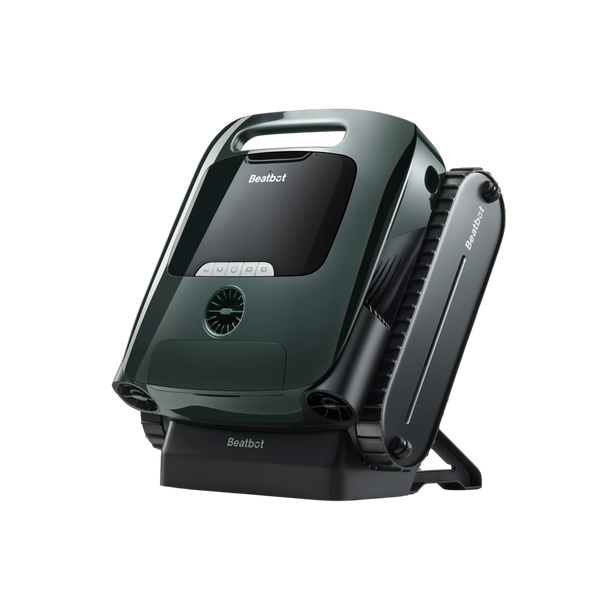Red Algae: A Comprehensive Guide to Effective Pool Cleaning and Prevention
Pink stains creeping up your pool walls? Don't panic yet. Your crystal-clear oasis needs some help, and we've got your back with the real scoop on handling this pesky problem.
Table of content

What Makes Red Algae Different?
Walk past any pool with red algae, and you might think it's just another type of growth. Wrong! That pink stuff clinging to your walls isn't algae at all – it's bacteria.Ever tried wiping it off? Then you know this stuff sticks like old gum to a shoe. Green algae just floats around doing its thing, but red algae? It's the houseguest that won't leave. Skimmer baskets, pool steps, corners – nowhere is safe once this bacteria decides to move in.Hot weather makes it worse. One day you spot a tiny pink patch, and before you know it, half your pool wall looks like it's blushing. Trust me, this isn't the kind of pool party you want to host.
Spotting the Early Warning Signs
You'll want to catch this stuff early unless you enjoy spending your weekends scrubbing pool walls. Here's what to watch for:Found some weird pink spots in those quiet pool corners? That's where it starts. Ladder areas and steps are prime real estate for these bacterial squatters. Run your hand along the wall – feel that slick film? Normal pool walls don't feel like that.The really frustrating part? Clean those stains away, and they show up again three days later like bad makeup. Notice the water getting cloudy near the walls? Red algae's probably throwing a party in there. Better crash it before the whole pool gets involved.
The Real Dangers of Red Algae
Beyond looking gross, this stuff means business. Those pink patches aren't just sitting there looking pretty – they're actually eating into your pool finish. Ignore them long enough, and you're looking at some costly repairs.Some swimmers end up with itchy skin after swimming in affected pools. Sure, not everyone gets rashy, but why risk turning your refreshing dip into an itchy nightmare? The longer these bacteria hang around, the deeper they dig in. What starts as a quick wipe-down can turn into a weekend-long scrubbing marathon.Pool maintenance is all about timing. Wait too long with red algae, and it's like letting a tiny leak become a flood. Save yourself the headache – deal with it now, not later. Ready to learn how? Keep reading.

Testing and Water Chemistry Basics
Water chemistry stops red algae cold. Break out your test kit – you'll need these numbers spot-on to win this fight.
Understanding Your Pool's Chemistry
Chlorine sits at the heart of your defense plan. But here's something most pool owners miss: combined chlorine matters more than total chlorine when fighting red algae. Crank up that free chlorine level between 2-4 ppm. Any lower and you're basically rolling out the welcome mat.Your pool's alkalinity sets the stage. Keep it dancing between 80-120 ppm. Why? Low alkalinity makes your other chemicals go haywire. Picture throwing darts blindfolded – that's your chlorine without proper alkalinity backup.
The Perfect pH Balance
Think Goldilocks – not too high, not too low. pH sweet spot? 7.4 to 7.6. Red algae throws a party when pH drifts up past 7.8. Drop a pH decreaser if you're running high. But watch out – go too low and you'll wreck your pool surface faster than red algae ever could.
Proven Removal Methods That Work
Forget what you've heard about quick fixes. Here's the real deal on kicking red algae out:First, shock your pool. Hard. Triple the normal dose after sunset. That means adding 3 or 4 pounds of calcium hypochlorite shock per 10,000 gallons of water. Test the water between each application of shock. And remember to shock your pool at dusk or night. Daytime shocking? Waste of chemicals. Sun burns through chlorine faster than a kid goes through pool toys. Then, with the pump still off, let the pool sit overnight.Grab a stiff brush – those soft ones won't cut it. Work the walls in sections. Ten minutes per area minimum. Miss a spot? You'll meet that pink stuff again next week.Run your filter 24/7 until the water sparkles. Backwash daily. Yes, your electric bill will spike. But it beats starting over because you got cheap with filter time.Chlorine continues to run at 5 PPM for the next week. You’ll want to test the water daily to ensure it’s this high. Wait a week, and allow the chlorine to go back down to 3 PPM, at this point, balance the water like you always do and get all levels to where they are supposed to be. You’ll want to keep an eye on your pool for a week or so to ensure the pink bacteria doesn’t return. During this time, it may be beneficial to run the pump as much as you can and brush and vacuum the pool at least every other day.
Prevention Strategies Worth Your Time
Daily Maintenance Tips
Prevention beats cure every time. Run your pump at least 8 hours daily. More in summer. Less in winter. But never skip a day.Brush those walls weekly, even when they look clean. Red algae loves to sneak in microscopic colonies. Regular brushing breaks them up before they get cozy.
Seasonal Care Guide
Winter coming? Don't slack off. Cold weather just slows red algae down – doesn't kill it. Keep chlorine levels steady year-round.Summer hits different. Check chemistry twice weekly minimum. Hot days burn through chlorine like nobody's business. Consider adding a UV system if you're fighting constant battles.Salt pools aren't immune either. Check your cell monthly. Scale buildup cuts chlorine production. No chlorine means red algae moves back in.
When to Call a Professional
Sometimes DIY hits a wall. Red algae shouldn't stick around after a week of solid treatment. Still seeing pink? Time to make that call.Watch for these red flags: Chemical levels stay wonky no matter what you try. Pink stains refuse to budge after multiple shocks. Water stays cloudy longer than three days post-treatment.Smart pool owners know their limits. Pros pack specialized tools and commercial-grade treatments you can't buy at the pool store. Worth every penny when stubborn cases pop up.
Final Thoughts on Prevention
Skip the headache entirely. Your pool routine makes or breaks algae prevention. Remember:Test strips lie. Spring for a good testing kit. Digital testers work best. Replace filter media yearly. Old filters harbor bacterial colonies. Track your chemical usage. Sudden spikes spell trouble coming.Fix small issues fast. Pool care works like dominos – one thing falls, everything follows. Keep your chemistry stable, and red algae won't dare show its face.
The Bottom Line
Red algae control boils down to staying sharp. Watch those corners and steps. Keep your brush handy. Test regularly.Skip the bargain bin chemicals. Quality matters here. Proper treatment costs less than fixing damage from cheap solutions.Your pool deserves better than pink stains and slimy walls. Armed with this guide, you're ready to keep that water crystal clear all season long.Remember: consistency beats intensity. A daily quick check prevents weekly deep scrubs. Stay on top of it, and red algae becomes somebody else's problem.
Relative Blogs
About the author



















